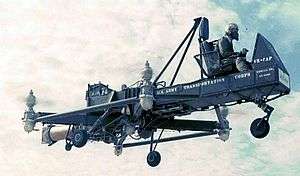Curtiss-Wright VZ-7
| VZ-7 | |
|---|---|
 | |
| Role | VTOL utility aircraft |
| National origin | United States |
| Manufacturer | Curtiss-Wright |
| First flight | 1958 ? |
| Retired | 1960 |
| Status | Cancelled |
| Primary user | USAF |
| Number built | 2 |
|
| |
The Curtiss-Wright VZ-7 (also known as the VZ-7AP[1]) was a VTOL quadrotor helicopter aircraft designed by the Curtiss-Wright company for the US Army. Like the Chrysler VZ-6 and the VZ-8 Airgeep it was to be a "flying jeep" .
Design and development
Two prototypes were delivered to the US Army in mid-1958.
The VZ-7 had a fuselage with the pilot's seat, fuel tanks and flight controls. On both sides of the fuselage the propellers were attached, unshrouded (the aircraft did originally have shrouds, but these were later removed). There were 4 propellers in total. The VZ-7 was controlled by changing the thrust of each propeller. The flying platform was maneuverable and easy to fly.
The aircraft performed well during tests, but was not able to meet the Army's standards, therefore it was retired and returned to the manufacturer in 1960.
One VZ-7 is part of the United States Army Aviation Museum aircraft collection at Fort Rucker. However, it's not on public display due to space restrictions.[2][3]
Specifications
Data from
General characteristics
- Crew: One pilot
- Length: 17 ft 0 in (5.18 m)
- Width: 16 ft 0 in (4.87 m)
- Height: 9 ft 3 in (2.83 m)
- Powerplant: 1 × Turbomeca Artouste IIB turboshaft, 430 hp (320 kW)
Performance
- Maximum speed: 32 mph (51 km/h)
- Service ceiling: 200 ft (60 m)
See also
- Aircraft of comparable role, configuration and era
References
- ↑ "The American Industry" Flight 19 August 1960 p247
- ↑ Rotary Wing Collection of the US Army Aviation Museum Archived July 13, 2012, at the Wayback Machine.
- ↑ Forum discussion with many pictures of aircraft in storage (incl. the VZ-7)
External links
| Wikimedia Commons has media related to Curtiss-Wright VZ-7. |